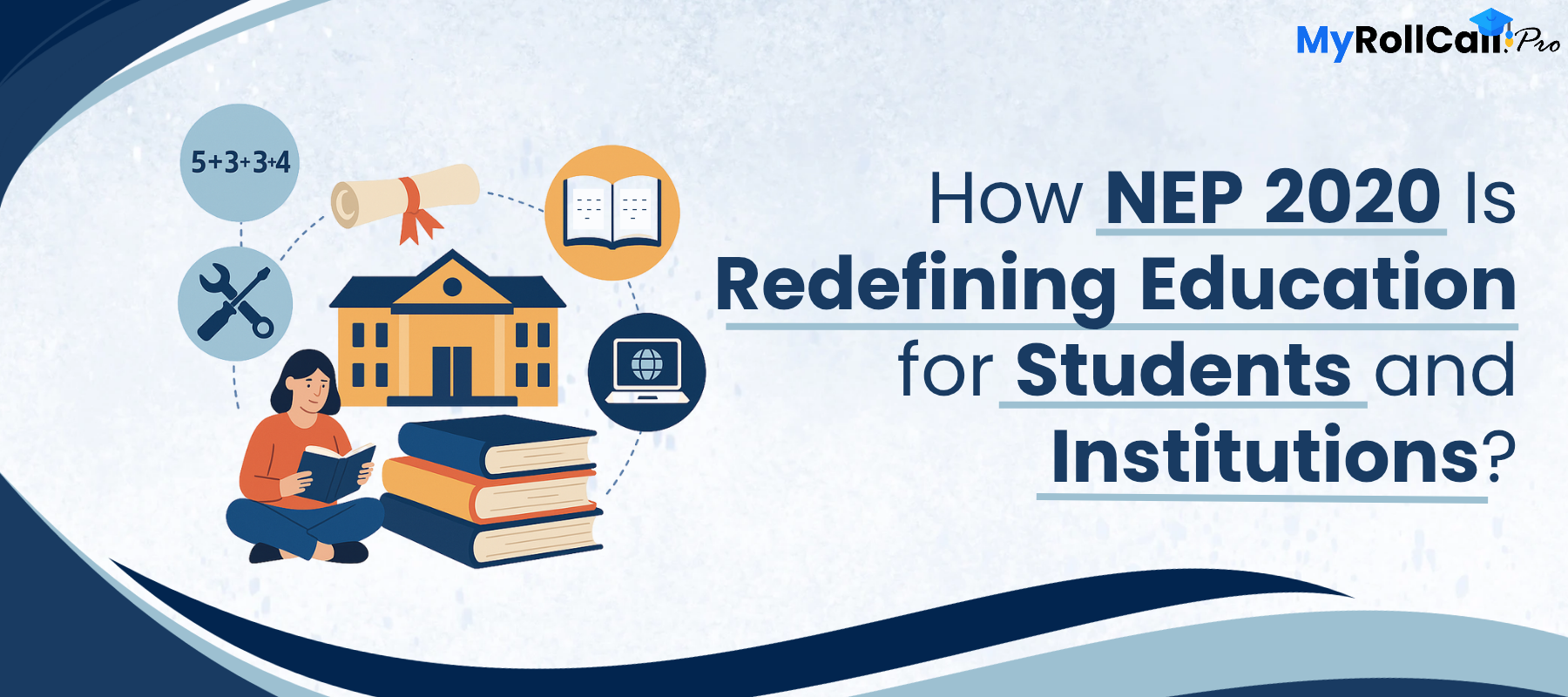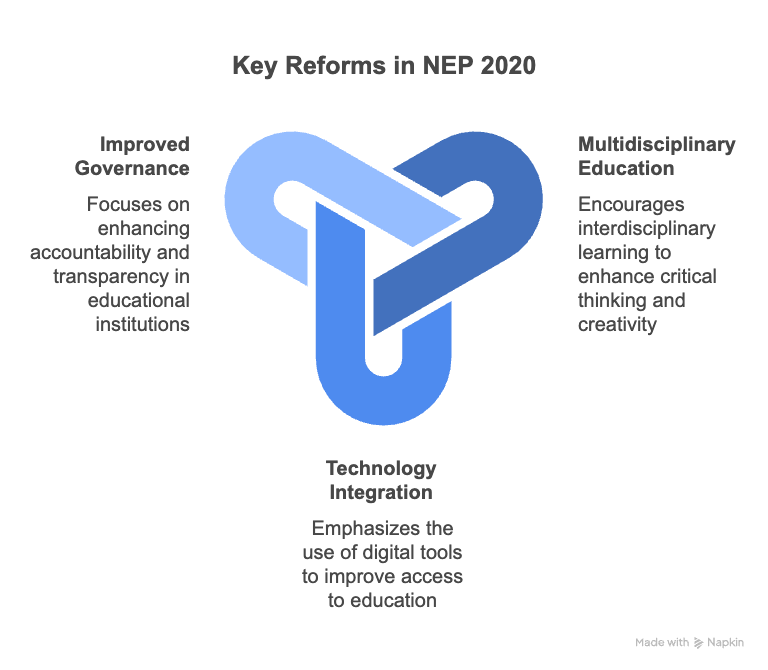
How NEP 2020 Is Redefining Education for Students and Institutions
The National Education Policy (NEP) 2020 is a game-changing initiative aimed at transforming India's education landscape. With an emphasis on inclusivity, flexibility, and the integration of technology, the policy sets the stage for the future of education in the country. By introducing reforms that impact everything from curriculum design to administrative functions, NEP 2020 is set to redefine the way education is managed and delivered across the nation. For higher education institutions, embracing digital tools and solutions will play a crucial role in aligning with these ambitious changes.
In this blog, we explore the core components of NEP 2020, its implications for students and institutions, and how digital tools can aid in streamlining educational management.
What is NEP 2020?
The National Education Policy 2020 is a progressive framework that aims to overhaul India’s education system. Aimed at ensuring equitable access to quality education, the policy emphasises the need for a holistic learning approach, better teacher training, and the integration of technology in educational processes.
With its clear focus on creating a more inclusive, flexible, and technology-driven education system, NEP 2020 addresses the long-standing gaps in India’s educational infrastructure. For institutions, adopting digital tools to manage processes like attendance, assessments, and reporting is critical to meeting the evolving standards set forth by the policy.
Key Highlights of the New Education Policy 2020
NEP 2020 brings several reforms that aim to align India's education system with international best practices. Some of the key highlights of the policy include:

1. Multidisciplinary Education
The policy promotes a shift toward multidisciplinary learning, where students are free to choose from a wide range of subjects, promoting interdisciplinary education. This will not only enhance students’ critical thinking and creativity but also equip them with a more comprehensive skill set that aligns with the demands of the future workforce.
2. Focus on Technology Integration
NEP 2020 emphasises the integration of digital tools into education. It highlights the importance of online resources, digital learning platforms, and other technological tools to enhance access to education, especially in remote areas.
3. Improved Governance
The policy focuses on improving governance within educational institutions, ensuring better accountability and transparency. This includes utilising data for decision-making and ensuring efficient use of resources, which can be supported by digital administrative systems.
Institutions aiming to implement these reforms will require efficient administrative systems to track attendance, manage academic data, and ensure smooth operation. Here, the role of digitally integrated attendance systems becomes vital in creating a transparent and streamlined academic environment.
Impact of NEP 2020 on Students and Institutions
The NEP 2020 focuses on creating a more student-centric learning environment by:
Providing Access to Diverse Learning: Students will now have the flexibility to choose from a variety of courses, fostering interdisciplinary education.
Enhancing Learning Experiences: The policy encourages the use of technology and online resources, ensuring that students have access to the best educational tools.
Increased Focus on Skill Development: With vocational education being integrated into mainstream education, students will be better prepared for the workforce.
A report from the https://www.ibef.org/industry/education-sector-india suggests that India’s higher education system is one of the largest in the world, with over 37 million students enrolled in various higher education programs. This figure underscores the need for a more flexible and inclusive system, as advocated by NEP 2020, to accommodate such a large and diverse student base (IBEF - Higher Education).
Impact on Institutions
For higher education institutions, NEP 2020 will require significant adjustments to administrative and academic processes:
Improved Data-Driven Decision Making: By focusing on data collection and analysis, institutions can make more informed decisions about student outcomes and institutional operations. Digital tools that automate attendance tracking and reporting can contribute to this process.
Enhancing Administrative Efficiency: NEP 2020 calls for streamlining administrative functions, including tracking student attendance, which can be made more efficient with digital systems.
According to a study by The World Bank, the adoption of digital tools in educational management can improve institutional efficiency by up to 25% through automation and better data utilisation.
For a deeper understanding of how digital attendance systems can enhance institutional efficiency, you might find this article insightful: How Student Attendance Management System Improves Efficiency.
How NEP 2020 Aligns with Global Standards
NEP 2020 aligns closely with global education trends, which increasingly emphasise technology integration, personalised learning, and data-driven governance. Key trends include:
Emphasis on Critical Thinking and Problem-Solving: Globally, educational systems are moving away from rote learning towards models that encourage creative and analytical thinking, a principle also reflected in NEP 2020.
Use of Technology: The global trend toward adopting digital tools in education is mirrored in NEP 2020, which stresses the importance of online resources and digital platforms for enhancing the learning experience.
To remain competitive and align with global educational practices, institutions must adopt modern tools to manage their administrative operations, particularly in areas like attendance management and data analytics.
Opportunities Presented by the New Education Policy 2020
NEP 2020 provides numerous opportunities for institutions and students, some of which include:
Collaboration with International Institutions: The policy encourages global collaborations that can open up opportunities for student exchange programs, joint research initiatives, and knowledge-sharing.
Increased Focus on Research and Development: With the new focus on research and innovation, institutions have the chance to attract global talent and improve their academic standing.
In addition, the integration of digital tools in academic administration opens up opportunities for institutions to manage student attendance and academic performance efficiently, allowing them to focus more on enhancing educational quality.
For educators aiming to monitor and improve student outcomes effectively, understanding key academic performance metrics is crucial. This article provides valuable insights: What Are the Key Academic Performance Metrics Every Educator Should Know.
Challenges in Implementing the New Education Policy
While NEP 2020 is a significant step forward, its implementation is not without challenges:
Infrastructure Gaps: Many educational institutions, particularly those in rural and remote areas, face significant infrastructure challenges, including limited internet access and a shortage of digital devices.
Resistance to Change: Some institutions and educators may be resistant to adopting digital systems and new governance models, which could hinder the policy’s full implementation.
Training and Development: Teachers and administrators will need extensive training to use new digital tools and align with the updated curricula.
Despite these challenges, the potential benefits of NEP 2020, including the opportunity to improve operational efficiency, cannot be overlooked. Institutions that embrace digital tools can play a pivotal role in overcoming these challenges.
Conclusion
NEP 2020 represents a bold and necessary step towards transforming India’s educational landscape. By focusing on technology, flexible learning, and data-driven decision-making, the policy promises to make education more inclusive, equitable, and globally competitive.
To successfully navigate these changes, higher education institutions must adopt digital tools that can help them streamline administrative processes, ensure transparency, and enhance student engagement. With its emphasis on data collection, attendance management, and improved governance, NEP 2020 provides a clear roadmap for institutions to follow.